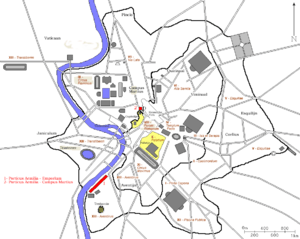Porticus Aemilia
Porticus Aemilia was a portico in ancient Rome. It was one of the largest commercial structures of its time and functioned as a storehouse and distribution center for goods entering the city via the Tiber river.

History and description
The portico was built in 193 BC by aediles Marcus Aemilius Lepidus and Lucius Aemilius Paulus from which the name of the structure and association to the gens Aemilia is derived (Livy, 35.10.12). It was subsequently rebuilt in 174 BC by censors Quintus Fulvius Flaccus and Aulus Postumius Albinus (Livy, 41.27.8).
The development of the Porticus coincided with the rapid growth of the city after the Second Punic War.[1] This increase, in both trade and population, placed stresses on the limited space available in the Forum Boarium and underlined the importance of the river link to Rome's main port at Ostia. The Porticus and the Emporium appear to have worked together to facilitate the unloading, storage, and possibly redistribution of goods and foodstuffs, including imported grain for the corn dole, and appear to have been in continuous operation until the 6th century CE.[2]
The opus incertum building, in the form of a thin rectangle running parallel to the Tiber, was very large; approximately 487 metres (1,598 ft) long, 60 metres (200 ft) deep and subdivided by 294 pillars in rows of seven. These created a series of 50 aisles, each 8.30 metres (27.2 ft) across. They were roofed by a series of overlapping vaults that rose in line with the slope of the hill, offering protection from the elements while allowing in light and air. The total covered surface was 25,000 square metres (270,000 sq ft).[3]
The building was set back approximately 90 metres (300 ft) from the Emporium and river access, possibly to mitigate the effects of seasonal flooding. By the Trajanic period this space was filled with additional commercial structures, and the large utilitarian spaces in the Porticus were put to a variety of uses, often modified or subdivided to suit the needs of their users.[1]
See also
Notes
- Filippo, Coarelli (2014-05-10). Rome and environs : an archaeological guide (Updated ed.). [Berkeley]. ISBN 9780520282094. OCLC 874923103.
- Brughitta, Cristiano. "Soprintendenza Speciale per i Beni Archeologici di Roma " La Porticus Aemilia regala un giardino a Testaccio"". Ministry of Culture, Superintendent of Archaeology. Retrieved 10 March 2018.
- "Porticus Aemilia, Soprintendenza speciale per i beni archeologici di Roma". Archived from the original on 2014-05-22. Retrieved 2012-06-30.
External links
- Ricerche in corso sui magazzini romani - Study meeting of 13–15 April 2011, Rome, National Roman Museum (in Italian only).
- Scavi in corso dal 2011 per una indagine archeologica - From the website of the Italian Society for the Protection of Cultural Heritage (in Italian only).
Bibliography
| Wikimedia Commons has media related to Porticus Aemilia. |
- Filippo Coarelli, Guida archeologica di Roma, Verona, Arnoldo Mondadori Editore, 1984.
- Lucos Cozza and Pier Luigi Tucci, Navalia, in Archeologia Classica 57 (2006), pp. 175–202.
- Giovanna Maria Forni, Extra Portam Trigeminam, in Atlante Tematico di Topografia Antica 22 (2012) pp. 35–40.
- Pierre Gros and Mario Torelli, Storia dell'urbanistica. Il mondo romano, Rome-Bari, Laterza, 2007.
- Giovanni Battista Piranesi, Le antichità Romane, T. 4, tav. Tav. XLVIII
- Pier Luigi Tucci, La controversa storia della Porticus Aemilia, in Archeologia Classica 63 (2012), pp. 575–591.